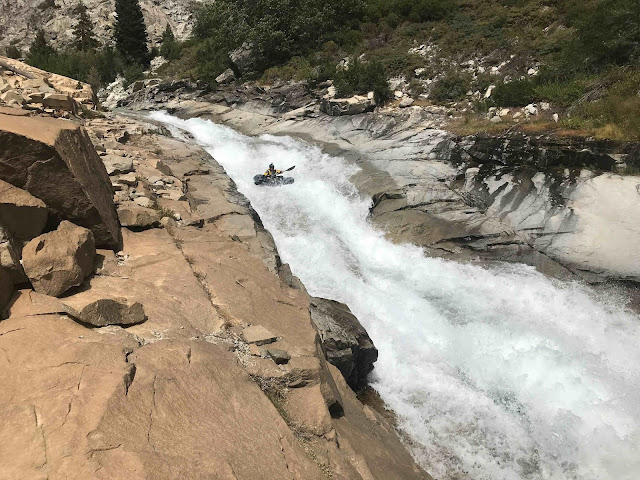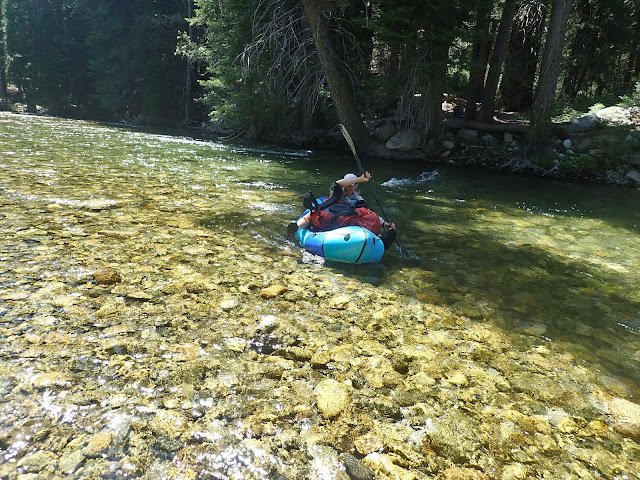Many years ago I was in a hut in British Columbia with a
group of friends and the hut (Fairy Meadows/Bill Putnam) is big enough to hold
two groups of people. The group that we
shared the hut with was from the Front Range of Colorado (aka Boulder/Denver and
environs). They were generally okay
folks, and from what we saw were generally good skiers who were doing as good a
job as we were at lapping up great powder runs.
After a few days I found myself sitting with a number of them over end
o’ day beers and decided I had to know: “So, you guys clearly are good skiers
and appreciate good skiing, and you are from Colorado, so I gotta ask: what’s the backcountry skiing like in
Colorado?” They enthusiastically took
turns telling me what it was like to be a backcountry skier in the Front Range,
and after quite some time one of them asked: “Well, what do you think?” I thought for a moment as I pondered my
reply, and finally shrugged and said: “I think that if I lived in Colorado, I
simply wouldn’t bother to go backcountry skiing.” Suffice to say, that pretty much ended that
conversation, and for that matter any subsequent conversations between them and
me for the rest of the week.
Since then, I’ve done a good handful of trips to Colorado,
and even been backcountry skiing in Colorado (once, at the dire-but-stable end
of the horrific drought year of 2017-18), and I have grown to like it. I’ve done a couple of great bike tours there
with Ashley, a great bikepack trip with Fred Marmsater (part
1 and part
2), and have done a handful of mountain bike/paddling trips there to enjoy
the Animas/Piedra, Blue, Cache Le Poudre, Roaring Fork, Crystal, Yampa, Delores,
Colorado, Taylor, Arkansas, and Gunnison rivers and their nearby trails,
including the past week when Colin Gregersen and I hit up the last few of
those.
 |
| Colin paddling Number 1 on the Arkansas River's Numbers section. |
Every time I visit, I’m struck by salient fact: people love to love Colorado.
In Utah there are almost daily sightings of the red “U” of
the University of Utah and the Blue “BYU” of, well, BYU on people’s cars, house
flags (like the new guy next door to us, so we are forced to see “U” daily), Tshirts, and
hats. It’s the same in every state, and it’s probably a function of
identification with an esteemed alma mater or simply a football thing. But Colorado is different: people display memorabilia showing the
Colorado flag. I’m sure that University
of Colorado and Colorado State have their fans, and of course they even have
their own NFL team, but
you don’t see too much memorabilia from those institutions; instead you see
people wearing the big sunburst C hats on Tshirts, sweatshirts, and stickers on
their cars. I doubt that many Utahns
would even recognize the UT state flag, much less be proudly sporting it on
their head. So relatively speaking, Coloradans
seem like a proud lot.
 |
| Our shuttle driver Joe was not sporting his CO flag hat or shirt this day but no doubt he has plenty. |
And they should be: Denver is by far the most significant
city between Chicago and the biggies of the West Coast, they have lots of nice
mountains and rivers, pretty favorable weather, and a thriving economy. But
every time I go I seem to find that people are awfully smug about it, yet - for sure, like everywhere – there are some
flaws.
My hut mates who regaled me with tales of backcountry skiing
in ‘Rado pretty much told me a narrative that to me seemed filled with traffic
(that comes in two parts: desperately
weaving through the gauntlet of the Front Range maze to even get close to
getting into the mountains, then tackling the 2-lane parking lot known as
I-70), big avalanche-prone terrain filled with precariously-loaded windjacked snow,
and backcountry crowds. The Colorado
resorts have a skier density of 427 skier days per acre, which is over twice as
high as Utah’s 180 skier days/acre (ironically, there used to be 175 operating ski
resorts in Colorado; now there are only 30). But boy, those three weeks of spring skiing
after Independence Pass opens and before it all turns to suncups, the skiing is
great! The rivers are nice, but the
shortness of the good sections makes the paddling feel a bit contrived and the
prevalence of private property on the banks of many rivers and their
belligerent owners has been such an issue that American Whitewater has 4 of
their 8 staff members based in the state.
Ah, but the mountains! The Fourteeners! There are so many! Yes, there are 53 peaks over 14,000 feet, but
I would guess that ‘Radoans hate the fact that they are all slightly short of
California’s 14,500 foot Mt Whitney (but Cali only has eleven more fourteeners!). If I ever feel like poking a Colorado
native a little I say something like: “the great part about Colorado is that - unlike some other western states - all your
big peaks are so easily accessible!” The
long history of mining in Colorado basically created an amazing network of
mountain roads (that make for great cycling) and indeed it’s a great asset for
people who like to efficiently get into elevated mountains.
Speaking of elevation, people love to be high in
Colorado. I could of course be referring
to the tired old trope of “high” as it’s associated with their pride in being
the first to legalize pot, but I’m actually referring to the even more-tired
trope of the elevation of most Colorado places.
I usually hear what elevation every ‘Radoan lives at within the first
few minutes of a conversation with them, but the truth is that I probably
already know, because I am regaled by their city signs that don’t bother with
population, just their elevation:
Actually, it probably saves money; the elevation never
changes, so the signs don’t need to every after each census!
Perhaps Coloradoans are just exhibiting yet another example
of the tribalism that seems to be getting ever-more entrenched in our society.
I just saw a quote from a book called “Sapiens” that “Humans evolved to think
of people as divided into us and them.”
So apparently it’s natural for “us” to think of “them” as having lesser
mountains/beauty/recreation? And the tribalism can be also get to the fraternal level; Colorado is the only place I know where people actively cultivate "secret" trails that the kool kids try to keep the gumbies away from.
Of course, anyone who lives in Colorado who is reading this
is probably at best offended (but I’ve probably lost them by now) and at worst
furious and can’t wait to take me out and kick my sorry ass by skiing the likes
of Capitol
or Pyramid Peaks, running Nolan’s
14 or Hardrock, paddling the Crystal
Gorge and Yule Creek,
riding the Colorado
Trail Race, climbing the Diamond, or climbing the walls of the very intimidating Black Canyon:
Colorado does have great stuff,
and I do indeed keep going back: last week I declared that the mountain biking there
is better than Utah’s (there seem to be more trails and they seem to me to be
rockier/more technical/longer:
 |
| I walked a lot of sections of this trail |
 |
| I don't do this much on Park City's buffed trails; if “better” is “harder” then it’s better in Colorado |
There’s
a lot to be said for accessible mountains (once you get into them), short and good
rivers are better than an almost utter lack of rivers (Utah), depending on
where you are there’s decent proximity to the (Utah) desert (which, to be fair,
Utahns also love to love), and the west slope’s fruit-growing ability is
legendary:
 |
| them Palisade peaches are big, juicy, and tasty! |
So while anyone from Cool-orado probably would angrily tell
me to “get out and stay out!” of their lovely state, I’ll no doubt continue to
return and enjoy what Colorado has to offer, and instead of poking people I’ll
be outwardly envious of so many 14ers, admire their many little rivers, sing
the praises of their mountain biking, shake my head at how great it is that
they have legal weed I don’t smoke, and of course ask them: “and remind me again at what elevation live
at?!!?”








































